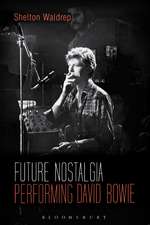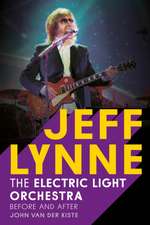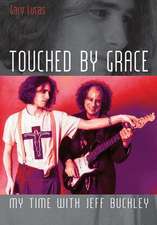Experimental Music Since 1970
Autor Jennie Gottschalken Limba Engleză Paperback – 10 aug 2016
| Toate formatele și edițiile | Preț | Express |
|---|---|---|
| Paperback (1) | 194.50 lei 3-5 săpt. | |
| Bloomsbury Publishing – 10 aug 2016 | 194.50 lei 3-5 săpt. | |
| Hardback (1) | 833.88 lei 6-8 săpt. | |
| Bloomsbury Publishing – 10 aug 2016 | 833.88 lei 6-8 săpt. |
Preț: 194.50 lei
Preț vechi: 240.11 lei
-19% Nou
Puncte Express: 292
Preț estimativ în valută:
37.22€ • 38.96$ • 30.80£
37.22€ • 38.96$ • 30.80£
Carte disponibilă
Livrare economică 15-29 martie
Preluare comenzi: 021 569.72.76
Specificații
ISBN-13: 9781628922479
ISBN-10: 1628922478
Pagini: 304
Ilustrații: 40 b/w images
Dimensiuni: 152 x 229 x 20 mm
Greutate: 0.5 kg
Editura: Bloomsbury Publishing
Colecția Bloomsbury Academic
Locul publicării:New York, United States
ISBN-10: 1628922478
Pagini: 304
Ilustrații: 40 b/w images
Dimensiuni: 152 x 229 x 20 mm
Greutate: 0.5 kg
Editura: Bloomsbury Publishing
Colecția Bloomsbury Academic
Locul publicării:New York, United States
Caracteristici
A resource to discover new ways of listening for professional musicians and non-musicians alike.
Notă biografică
Jennie Gottschalk is a composer and independent scholar based in Boston. Since receiving a doctorate in composition from Northwestern University in 2008, she has traveled extensively to gather first-hand information about experimental music practices. For additional resources related to this book, please visit the author's website at soundexpanse.com.
Cuprins
Chapter 1: Defining Features of Experimental Music1.1. Introduction1.2. Indeterminacy1.3. SilenceChapter 2: Scientific Approaches 2.1. Acts of Discovery2.2. Harmonic Relations2.3. Playing with Numbers2.4. Learning by Making2.5. Finding Hidden SoundsChapter 3: Physicalities 3.1. The Physicality of Performance3.2. Resonant Spaces3.3. Objects as Instruments3.4. From Shape to SoundChapter 4: Perception 4.1. The Position of the Listener4.2. The Perception of TimeChapter 5: Information, Language, and Interaction 5.1. Treatments of Sonic Information5.2. The Sounds of Living Beings5.3. Language5.4. InteractionChapter 6: Place and Time 6.1. Mappings6.2. Site-Specific Works6.3. HistoriesChapter 7: Advocates Appendix Index
Recenzii
Experimental Music Since 1970 is destined to become a standard reference work. It is comprehensive and well organised, and it gives a good picture of the scope of the subject. ... Gottschalk's book is somewhat like a brilliant encyclopedia with informative summary passages on various makers and elements of experimental music. ... I will certainly be putting [it] on my booklists for undergraduates.
[Full of] lucid and engaging discussion of so much music new to me, which has had me scurrying to Youtube, download sites and the library to find examples. Gottschalk's book is enthusiastic, highly readable and does not attempt to be too definitive in its explorations.
Readers hungry for a broader view of the field will be enticed here by the buffet of younger and lesser-known artists [in the Table of Contents] from all corners of the globe, as well as Anglo-American veterans and icons.
We have needed a reformulation of what experimental music now means, i.e., what has become since Michael Nyman took stock of it in 1974-and this book beautifully fulfills that requirement. Jennie Gottschalk takes a fresh and independent look at experimental music of the last forty years, finding both points of continuation from the previous era and many novel and heartening developments. It is also an adventure story with surprising twists and a panoramic cast of characters, like a novel in which works and ideas are the central figures, seemingly with a collective life of their own.
Reading Experimental Music Since 1970 it is impossible not to be dazzled first by the range and imagination of experimental music and sound art that is being made today, and second by the way in which Jennie Gottschalk has described and catalogued so much of it, so lucidly. Impeccably and authoritatively researched, by a writer who is both a practitioner and an astute observer, it deserves to be the go-to reference for years to come.
This book is a unique achievement. Without catering to current fashions or well-worn academic assumptions, it transcends the limits of both journalism and traditional musicology to be both comprehensive and insightful. Reading it has helped me to ask new questions about a history that I thought I knew quite well.
[Full of] lucid and engaging discussion of so much music new to me, which has had me scurrying to Youtube, download sites and the library to find examples. Gottschalk's book is enthusiastic, highly readable and does not attempt to be too definitive in its explorations.
Readers hungry for a broader view of the field will be enticed here by the buffet of younger and lesser-known artists [in the Table of Contents] from all corners of the globe, as well as Anglo-American veterans and icons.
We have needed a reformulation of what experimental music now means, i.e., what has become since Michael Nyman took stock of it in 1974-and this book beautifully fulfills that requirement. Jennie Gottschalk takes a fresh and independent look at experimental music of the last forty years, finding both points of continuation from the previous era and many novel and heartening developments. It is also an adventure story with surprising twists and a panoramic cast of characters, like a novel in which works and ideas are the central figures, seemingly with a collective life of their own.
Reading Experimental Music Since 1970 it is impossible not to be dazzled first by the range and imagination of experimental music and sound art that is being made today, and second by the way in which Jennie Gottschalk has described and catalogued so much of it, so lucidly. Impeccably and authoritatively researched, by a writer who is both a practitioner and an astute observer, it deserves to be the go-to reference for years to come.
This book is a unique achievement. Without catering to current fashions or well-worn academic assumptions, it transcends the limits of both journalism and traditional musicology to be both comprehensive and insightful. Reading it has helped me to ask new questions about a history that I thought I knew quite well.















